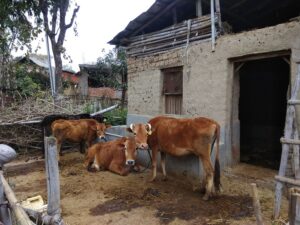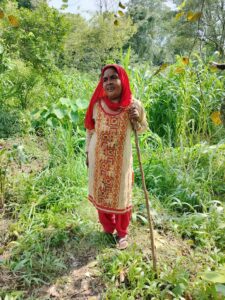Women farmers intuitively practice principles of agroecology. Their focus is not just on soil and crops by adopting sustainable practices, but also on the health of their family. Presented are two cases from Himachal Pradesh, which prove that with access to knowledge and technology, women chose to diversify their livelihoods, making their farms sustainable.
In India, women play a paramount role in agriculture. However, the decision-making power always remained in the hands of men or the elder women. Customarily, their roles are gender as well as technology biased. Activities that need the use of terrain-specific technology such as plowing with tractors or bulls are traditionally carried out by men while the activities with more drudgery like sowing seeds, removing weeds, harvesting yield, etc., are usually taken care of by women.
In hilly terrains of Himachal Pradesh, men farmers with limited livelihood opportunities on scattered and marginalized landholdings, have been migrating towards plains to explore other sources of income. This has resulted in women taking up farming responsibilities. With increased autonomy, women are found to make decisions that are more desirable for the family, beyond mere crop sustenance. The following cases belonging to our project area in the district of Kangra in Himachal Pradesh, highlight this.
Case of Attiji
Atti Ji is a 40-year-old farmer living in Sukarna village of Sakri Panchayat. She belongs to the Schedule Caste category. Her husband works as a daily wage labourer. She owns 27 kanals (8 kanals equals one acre) of agricultural land, of which cultivation is done on 25 kanals. While 18 kanals of the land is adjacent to her house, 7 kanals of land is located at a distance.

Livestock at Atti Ji’s house
Until 2017, the 18 kanals of land adjacent to her house, was covered with thorny shrubs, trees and vines. She says, “aadmi aar se paar nahi dikhta tha, yahan poora jungle tha” (it was so dense that no one could see from one side to the other of the land). To clear it, she invited local pastoralists – the Gaddi community, to graze their herd on her land. The livestock gave her a headstart on clearing the land. She then proceeded to cut down shrubs and vines with the help of hand tools. In cases where trees and more stubborn shrubs posed a challenge, she received help from Electricity department staff who were installing electricity poles on the adjacent plot. Season by season, she cleared small patches of land and started cultivating a variety of crops for which she was earlier dependent on other villagers and markets.
As the land was covered with trees for years, the freshly cleared land was extremely fertile. The output from this land was twice compared to other agricultural land, that her family had been cultivating for generations. Higher yield also allowed her the opportunity to sell the surplus in the local market and generate additional income. Next season, she grew soybeans on that land and then moved towards kitchen gardening called “Suadu” in the local language. Attiji never felt the need to use chemicals in this new plot as the land was extremely fertile. Apart from cereals and a kitchen garden, she also planted assorted fruit trees such as Mangoes, Indian Blackberries, Big lime, Indian gooseberry (Amla), Mulberry, and Guava. Attiji also owns 4 cows, out of which one is desi and 3 are hybrid. As she produces value-added products such as curd, ghee, and cheese at home, she usually doesn’t have enough milk surplus to sell in the market.
In 2022, under the Agricultural Technology Management Agency (ATMA) project, Attiji moved from traditional farming to organic farming. The project was introduced to her by a local NGO, Rural Technology Development Centre (RTDC). She underwent various on-field trainings, and exposure visits to learn contemporary farming techniques. In the last Kharif season, she cultivated vegetables like peas, onion, garlic, radish, potato, beetroot, field pea, grass pea, arugula, broad bean, and turmeric; and, cereals such as barley, finger millet, wheat, paddy and landrace seeds such as mustard and flaxseed.
Apart from vegetables and cereals, she also cultivated medicinal plants such as Chamomile and Spikenard. Dried Chamomile flowers can be used for tea. It also has medicinal value. The mature roots of Spikenard, 2 years or older, are used for making ayurvedic medicine. Furthermore, she started beekeeping in November 2022. Honey harvested from bee boxes not only helped her augment her income but bees helped pollinate the crop which impacted the yield.
Case of Brahmiji
Brahmiji lives with her husband and a son in the remote corner of Rajodu village of Kudail Panchayat in Kangra district. At the age of 22, after estrangement from extended family, Bramhi ji and her family left the ancestral house and started everything from scratch. At that time her husband used to work as a labourer in a nearby factory earning Rs 250 per month. While looking for better opportunities, her husband moved to Saudi Arabia to work as a mechanic, but in the next 3 years, he ended up losing all their savings. Brahmiji became the sole earner for a family of 5 members.

Brahmi Devi raised kitchen garden adjacent to her house
The first issue that Brahmiji tackled was to reduce her expenses by reducing market dependency. She started cultivating 4 kanals of land adjacent to her house. She started the kitchen garden – locally known as Suadu, with potato and radish. Over the years, the diversity of vegetables in her kitchen garden has grown to include spinach, turnip, turmeric, cauliflower, cucumber, and other seasonal leafy vegetables. Moreover, she now cultivates some rare and wild vegetables such as Snake gourd “Padol” and Winged Yam “Dioscorea alata” (local name- Tardi), that give better returns than other vegetables. She claims that the taste of her own vegetables is much better than the taste of what she used to get from the market. Initially, when she established her kitchen garden, she started getting a surplus of many vegetables and used to distribute it among family and friends free of cost. But then on the suggestion of one of her friends, she collected all the radishes, washed them and started selling them from household to household. This was the first time that she sold her vegetables and got a profit out of it. This small success motivated her to sell the surplus from her kitchen garden to villagers on a regular basis.
Later she planted various trees like mango, plum, big lime, orange, guava, and pomegranate on her field. However, this endeavour didn’t result in immediate success. The first challenge Bramhiji faced was attack by wild monkeys. They destroyed the harvest multiple times. This did not deter Brahmi ji. She started collecting fruits and vegetables that were damaged by monkeys and salvaged some of them to make chutneys and pickles for household consumption. Over the last three years, the number of monkeys visiting her farm reduced.
In 1999, she got a job as a helper in Anganwadi. Despite the new job she continued to work in her fields and learn new techniques and methods. In 2003, she was selected for training in vermicomposting by a regional agricultural block officer. Post-workshop, she started using cow dung and urine on her farm to increase soil fertility. Then in 2019, the Rural Technology Development Centre (RTDC) team introduced her to other farming techniques and learnt about Shri. Subhash Palekarji’s, natural farming method. She started practising Natural Farming principles with all the resources available to her. Instead of using cow dung and urine, she used buffalo dung and urine and got good results from that as well. During the pandemic, she hardly had to put much effort into selling the produce. Villagers would come to her house and buy good quality organic vegetables at 3 times the market price. With increased demand due to scarcity of resources, she also ended up selling leaves of turnips and radishes, which otherwise would have been discarded.
This year she has started growing large cardamom and finger millet. She has diversified her sources of income by producing value-added products like curd and ghee, from 2 buffaloes and a cow that she owns. In the month of March, she initiated the backyard poultry project with the support of the RTDC team.
Conclusion
When given the opportunity, women farmers intuitively practiced principles of agroecology. In both cases, women chose to reduce their market dependency by growing their own food. They also focused on the health of their family, crops and soil by adopting sustainable agri-practices. Taking into account the agroecological aspects, these women worked with the traditional system but didn’t restrict themselves from adopting new technology and knowledge. When given access to new knowledge and technology, they chose to diversify their sources of income, by providing a bundle of different products to local communities.
These women were not restricted by their social status or financial difficulties. Atti ji worked hard and capitalised on all the knowledge and support provided to her, to provide a better healthier life for children. Whereas, Bhramhi ji, beyond adopting the prevalent practices in natural farming, also experimented to generate new results. Both women showed exceptional success in achieving sustainable development through agroecology with their own efforts and understanding.
Acknowledgements
The support provided by Meena Devi- Community Resource Person (Himachal Pradesh), Rural Technology Development Centre (RTDC) is gratefully acknowledged.
Chhavi Bathla
Regional Coordinator (Himachal Pradesh)
Watershed Support Services and Activities Network (WASSAN)
E-mail: chhavi@wassan.org
Sai Nikam
Program Officer (Hyderabad)
Organization- Watershed Support Services and Activities Network (WASSAN)









